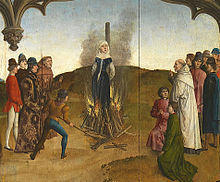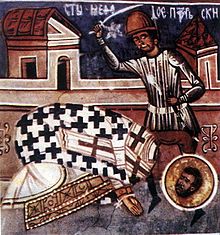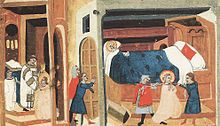19 September 2020
St. Peleus. September 19
St. Maria de Cerevellon. September 19
St. Maria de Cerevellon
September 19

Superior of the Mercedarians, the order of Our Lady of Ransom, also called Maria de Socos, "Mary of Help." Born into a noble family of Barcelona, Mary formed a group that evolved into the Mercedarians. She labored among the Christian slaves of the Moors, and she is the patroness of sailors in Spain. Maria died at Barcelona. Her cult was confirmed in 1690.
St. Goeric of Metz. September 19
St. Goeric of Metz
Death: 643
Bishop and successor of St. Arnulf at Metz, France. He is sometimes called Abbo or Goericus. He was supposedly a courtier at the court of King Dagobert, who went blind and was cured miraculously. He then became a priestand bishop and founded a convent.
Goeric of Metz (Latin: Goericus; French: Goëri; died September 19 643 AD), also known as Abbo I of Metz, Goericus of Metz, and Gury of Metz, was a bishop of Metz.[1] He is venerated as a saint in the Eastern Orthodox and Roman CatholicChurches.
Biography
He was a married man with two daughters. He recovered his eyesight at St. Stephen's in Metz. Shortly thereafter, he joined the clergy and was ordained a priest by Arnulf of Metz. In 627, he succeeded Arnulf as bishop of Metz.
As bishop, he transferred the relics of his predecessor Arnulf to the Church of the Apostles. He also built the church of Great St. Peter's and the monastery at Epinal for his two daughters, Precia and Victorina. He was also a personal friend of Dagobert I.
He died in 643. He has the feast day of September 19. In the 10th century, his relics were brought from Saint-Symphorien to Epinal. This event is commemorated in the local Calendar of Saints on April 15.
St. Emily de Rodat. September 19
St. Emily de Rodat
Birth: September 6, 1787
Death: September 19, 1852
Beatified: June 9, 1940 by Pope Pius XII
Canonized: April 23, 1950 by Pope Pius XII

Born near Rodez, France, she became a nun at Maison St. Cyr when eighteen. In 1815 after much dissatisfaction, she decided that her vocation was in teaching poor children. With the approval of Abbe Marty, her spiritual adviser, and the aid of three young assistants, she began this work in her room at St. Cyr. This was the start of the Congregation of the Holy Family of Villefranche. It grew rapidly, establishing its own mother house and branches. In time, St Emily extended its activities to caring for unfortunate women, orphans and the aged. She saw thirty eight institutions established before she died. She was canonized in 1950. Feast date Sept. 19.
Émilie de Rodat (September 6, 1787 – September 19, 1852) was the founder of the French female order of Sisters of the Holy Family of Villefranche and a mystic.[1]
Pope Pius XII beatified her on June 9, 1940, and canonized her on April 23, 1950. Her feast day is September 19. Her foundation, created in the year 1815, focused on young women and girls with difficulties, prisoners of war and people in prison. It was not known during her lifetime that Emilie de Rodat was also a mystic. Her revelations are included in a diary, which was found after her death. At the time of her death, she had opened at least 38 charities
St. Arnulf. September 19
Bl. Alphonsus de Orozco. September 19
✠ புனிதர் ஜனுவாரியஸ் ✠(St. Januarius)செப்டம்பர் 19
சலேத்_அன்னை(செப்டம்பர் 19)
காண்டர்பரி பேராயர் தியோடர் Theodar. September 19
18 September 2020
✠ புனிதர் ஜான் மசியாஸ் ✠(St. John Macias)செப்டம்பர் 18
✠ புனிதர் ஜோசப் கப்பர்ச்சினோ ✠(St. Joseph of Cupertino). செப்டம்பர் 18
St. Richardis September 18
St. Richardis
Empress and wife of Emperor Charles the Fat. The daughter of the count of Alsace, she wed the future emperor and served him faithfully for nineteen years until accused of infidelity with BishopLiutword of Vercelli. To prove her innocence, she successfully endured the painful ordeal of fire, but she left Charles and lived as a nun, first at Hohenburg, Germany, and then Andlau Abbey. She remained at Andlau until her death.
Saint Richardis (Latin: Richgardis, Richardis), also known as Richgard, Richardis of Swabia and Richarde de Souabe in French (c. 840 – 18 September, between 894 and 896 AD), was the Holy Roman Empress as the wife of Charles the Fat. She was renowned for her piety, and was the first abbess of Andlau. Repudiated by her husband, Richardis later became a Christian model of devotion and just rule. She was canonised in 1049.
Contents
- 1 Life
- 2 The Legend of Richardis
- 3 Veneration
- 4 See also
- 5 Notes
- 6 Sources
Life
She was born in Alsace, the daughter of Erchanger, count of the Nordgau, of the family of the Ahalolfinger. She married Charles in 862 and was crowned with him in Rome by Pope John VIII in 881. The marriage was childless.[1]
Charles' reign was marked by internal and external strife, caused primarily by the constant plundering of Normanraiders on the northern French coast. These attacks had intensified as the aggressors, no longer content to pillage the coastline, had moved their attentions to cities and towns along the rivers. The Carolingian world was unable to effectively deal with these external threats.
By 887, Charles appears to have succumbed to fits of madness. During this crisis, Richardis attempted to rule in her husband's stead, but was unsuccessful. In an effort to bring down the over-powerful and hated Liutward, Charles' archchancellor, he and Richardis were accused by Charles and his courtiers of adultery. Charles asserted that their marriage was unconsummated and demanded a divorce. She was put to the ordeal by fire, which she passed successfully.
Protected by her family, she then withdrew to Andlau Abbey, which she had founded on her ancestral lands in 880, and where her niece Rotrod was abbess. (Richardis herself was previously lay abbess of religious houses at Säckingen and Zurich). She died at Andlau on 18 September and was buried there.
The Legend of Richardis

After her lifetime, a legend grew up around the life of Richardis. The legend relates that, despite being a virtuous wife, her husband continued to accuse her of misconduct. This he did for over ten years. In a bid to assure him of her innocence, she finally assented to an ordeal by fire. Though she was barefoot and wearing a shirt covered in wax, the flames nevertheless refused to touch her. Disheartened by her husband's continued mistrust, Richardis left the imperial palace and wandered into the forest. There she was visited by an angel, who ordered her to found a convent in a certain spot, which a bear would indicate to her. In Val d'Eleon, at the banks of the river, she saw a bear scratching in the dirt. There she built the abbey of Andlau.
An alternative legend recounts that Richardis found the mother bear grieving over her dead cub in the forest. When Richardis held the cub, it returned to life. After the working of this miracle, both mother and cub remained devoted to the saint for the rest of their lives.[2]
However, the abbey had already been founded seven years before her divorce from Charles the Fat, and the area had long been associated with the bear. Incorporating the mythos of the bear, the nuns at Andlau long maintained a live bear, and allowed free board and passage to passing bear-keepers. To this day images of the saint are still often accompanied by that of a bear.
Veneration
Richardis was later canonised and remains translated in November 1049 by Pope Leo IX to a more impressive tomb in the newly rebuilt abbey church. The present tomb dates from 1350.
Richardis is patron of Andlau, and of protection against fires. Her iconography refers to her status as an empress and nun and to her ordeal by fire. The bear and ploughshare refer to the foundation legend of Andlau Abbey.
St. Methodius of Olympus. September 18
St. Methodius of Olympus
Death: 311

Bishop and martyr, famous for his writings. St. Jerome wrote of his martyrdom at Chalcis, in modern Greece. Methodius was the bishop of Olympus, Lycia, in Asia Minor. He then ruled Tyre, Lebanon, or possibly Patara, in Lycia, and was the author of the treatise On the Resurrection and the Symposium .


Saint Methodius of Olympus(died c. 311) was a Christian bishop, ecclesiastical author and martyr today regarded as a Church Father. He is commemorated on June 20.[2]
Contents
- 1 Life
- 2 Works
- 3 Doctrines
- 3.1 Virginity of Jesus Christ
- 4 Notes
- 5 Further reading
- 6 External links
Life
Few reports have survived on the life of this first systematic opponent of Origen; even these short accounts present many difficulties. Eusebius does not mention him in his Church History, probably because he opposed various theories of Origen. We are indebted to Saint Jeromefor the earliest accounts of him.[3]According to him, Methodius was Bishop of Olympos in Lycia and afterwards Bishop of Tyre. No later Greek author knows anything of his being Bishop of Tyre; and according to Eusebius,[4]Tyrannio was Bishop of Tyre during the persecutions of Diocletian and died a martyr; after the persecution Paulinus was elected bishop of the city. Later sources make him bishop not of Olympos but of Patara, also in Lycia. It has been conjecture that he could have held both sees simultaneously, but this is unlikely.[5]
Jerome further states that Methodius suffered martyrdom at the end of the last persecution, i.e., under Maximinus Daia(311). Although he then adds, "that some assert", that this may have happened under Decius and Valerian at Chalcis, this statement (ut alii affirmant), adduced even by him as uncertain, is unlikely. Various attempts have been made to clear up the error concerning the mention of Tyre as a subsequent bishopric of Methodius; it is possible that he was transported to Tyre during the persecution and died there.
Works
Methodius had a comprehensive philosophical education, and was an important theologian as well as a prolific and polished author. Chronologically, his works can only be assigned in a general way to the end of the third and the beginning of the 4th century. He became of special importance in the history of theological literature, in that he combated various views of the great Alexandrian, Origen. He particularly attacked his doctrine that man's body at the resurrection is not the same body as he had in life, as well as his idea of the world's eternity. Nevertheless, he recognized the great services of Origen in ecclesiastical theology.[6]
Like Origen, he is strongly influenced by Plato's philosophy, and uses to a great extent the allegorical explanation of Scripture. Of his numerous works only one has come down to us complete in a Greek text: the dialogue on virginity, under the title Symposium, or on Virginity(Symposion e peri hagneias).[7] In the dialogue, composed with reference to Plato's Symposium, he depicts a festive meal of ten virgins in the garden of Arete, at which each of the participators extols Christian virginity and its sublime excellence. It concludes with a hymn on Jesus as the Bridegroom of the Church. Larger fragments are preserved of several other writings in Greek; we know of other works from old versions in Slavonic, though some are abbreviated.
The following works are in the form of dialogue:
- On Free Will (peri tou autexousiou), an important treatise attacking the Gnostic view of the origin of evil and in proof of the freedom of the human will
- On the Resurrection (Aglaophon e peri tes anastaseos), in which the doctrine that the same body that man has in life will be awakened to incorruptibility at the resurrection is specially put forward in opposition to Origen.
While large portions of the original Greek text of both these writings are preserved, we have only Slavonic versions of the four following shorter treatises:
- De vita, on life and rational action, which exhorts in particular to contentedness in this life and to the hope of the life to come
- De cibis, on the Jewish dietary laws, and on the young cow, which is mentioned in Leviticus, with allegorical explanation of the Old Testament food-legislation and the red cow (Num., xix)
- De lepra, on leprosy, to Sistelius, a dialogue between Eubulius (Methodius) and Sistelius on the mystic sense of the Old Testament references to lepers (Lev., xiii)
- De sanguisuga, on the leech in Proverbs (Prov., xxx, 15 sq.) and on the text, "the heavens show forth the glory of God" (Ps. xviii, 2).
Of other writings, no longer extant, Jerome mentions (loc. cit.) a voluminous work against Porphyry, the Neoplatonistwho had published a book against Christianity; a treatise on the Pythonissadirected against Origen, commentaries on Genesis and the Canticle of Canticles. Other authors attributed a work On the Martyrs, and a dialogue Xenon to Methodius; in the latter he opposes the doctrine of Origen on the eternity of the world. Gregory Abu'l Faraj attribute to Methodius some kind of work dealing with the patriarchs.[8]
The 7th-century Apocalypse of Pseudo-Methodius is falsely attributed to him. His feast day is September 18. Among the editions of his works are: P.G., XVIII; Jahn, S. Methodii opera et S. Methodius platonizans (Halle, 1865); Bonwetsch, Methodius von Olympus: I, Schriften(Leipzig, 1891).
St. Ludmilla of Bohemia. September 18
St. Ludmilla of Bohemia

St. Ludmila was the daughter of a Slavic prince, she married Duke Borivoy of Bohemia, whom she followed into the Church. They built a church near Pragueand tried unsuccessfully to force Christianity on their subjects. On the death of Borivoy, his sons Spytihinev and Ratislav, who had married Drahomira, succeeded him, and Ludmila brought up the latters son Venceslaus. On the death of Ratislav, Drahomira became regent, kept Wenceslaus from Ludmila and reportedly caused her to be strangled at Tetin. Her Feastday is September 16th.
Saint Ludmila (c. 860 – 15 September 921) is a Czech saint and martyrvenerated by the Orthodox and the Roman Catholics. She was born in Mělník[1] as the daughter of the Sorbianprince Slavibor.[2] Saint Ludmila was the grandmother of Saint Wenceslaus,[1] who is widely referred to as Good King Wenceslaus. Saint Ludmila was canonized shortly after her death. As part of the process of canonization, in 925, Wenceslaus moved her remains to the St. George's Basilica, Prague.
Contents
- 1 Marriage
- 2 Ludmila and Drahomíra
- 3 See also
- 4 References
- 5 Sources
Marriage
Ludmila was married to Bořivoj I of Bohemia, the first Christian Duke of Bohemia,[1] in 873. The couple was converted to Christianity through the efforts of Saint Methodius.[1][3] Their efforts to convert Bohemia to Christianity were initially not well received,[1] and they were driven from their country for a time by the pagans. Eventually the couple returned, and ruled for several years before retiring to Tetín, near Beroun.
The couple was succeeded by their son Spytihněv. Spytihněv was succeeded by his brother Vratislav. When Vratislav died in 921, his son Wenceslas became the next ruler of Bohemia.[3] It had been mainly Ludmila who raised her grandson and she now acted as regent for him.
Ludmila and Drahomíra

Wenceslaus' mother Drahomíra became jealous of Ludmila's influence over Wenceslaus. She had two noblemen Tunna and Gommon (probably of Frankish or Varangian descend) murder Ludmila at Tetín, and part of Ludmila's story says that she was strangled[1] with her veil. Initially, Saint Ludmila was buried at St. Michael's at Tetín.[4]
Saint Ludmila was canonized shortly after her death. As part of the process of canonization, in 925, Wenceslaus moved her remains to the St. George's Basilica, Prague.[3] She is venerated as a patroness of Bohemia. She is considered to be a patron saint of Bohemia, converts, Czech Republic, duchesses, problems with in-laws, and widows. Her feast day is celebrated on September 16th.
Antonín Dvořák composed his oratorio Svatá Ludmila (Saint Ludmila) between September 1885 and May 1886. The work was commissioned by the publisher Littleton for the Leeds Festival.[5]





